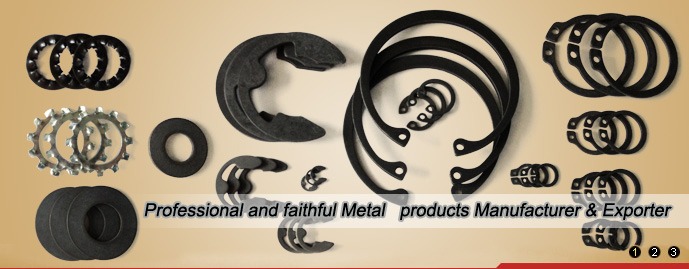Internal vs. External Retaining Rings
In general, there are two main types of retaining rings – internal retaining rings and external retaining rings. Internal retaining rings are placed into a groove in a housing. Often internal retaining rings are tapered from the top of the ring to the free end of the ring. This is to help with installation since the overall height of the ring decreases as it is compressed. As a result, the ring can easily be inserted into the housing and can spring back to a circular shape once installed. This enables the ring to grip the entire groove in the housing and hence withstand higher thrust loads.
External retaining rings, unlike internal ones, are placed on a groove directly on the shaft. Using a set of retaining ring pliers, external retaining rings are expanded and then spring back to their original shape when installed to form a tight hold. A portion of the ring protrudes out the groove and forms a shoulder to prevent components on a shaft from shifting.
Axially vs. Radially Installed Retaining Rings
Retaining rings can either be installed axially or radially. Axial installation means retaining rings are installed from the end of the shaft and slid along the shaft’s axis until it is placed in the necessary groove. Radial installation means retaining rings are installed from a direction perpendicular to the axis of the shaft. One major advantage of axially-installed retaining rings is that they contact the entire surface of the groove it is placed in. This allows axially-installed rings to transmit thrust loads throughout the entire groove wall – making these rings able to sustain high thrust loads.
Despite their name, radially-installed retaining rings actually resemble a half-circle and are sometimes called E-clips. This is because there are three prongs on the inside of the ring that contact the groove. Radially-installed retaining rings do not have lugs that allow them to be gripped by a set of retaining ring pliers. Additionally, because of their half-circle shape, these rings do cover the entire circumference of the groove and hence cannot sustain high thrust loads as effectively as their axially-installed counterparts. Despite that, two major advantages of radially-installed retaining rings are that they are easier to install than axially-installed rings and are more cost-effective than other fastening methods, including their axial counterparts.
Important Design Considerations for Retaining Rings
1. Thrust Load
Retaining rings are often used in heavy machinery to secure shafts and their components in industries like automobile and aerospace where they are used in engine and bearing assemblies. Unsurprisingly, thrust loads, or loads that are applied along the axis of a shaft, can be exceptionally high in these applications, especially when power transmission is involved. Thrust loads are one of three that result from the rotational meshing of gears in power transmission. During meshing, a reaction force normal to the contact area between the teeth of the gears develops. This resultant normal force can be broken down into two vector components: the axial (coming out the gear) and radial directions (towards the center of the gear). As gears rotate, the axial and radial forces will oscillate. Therefore, it’s critical that the retaining rings you purchase are rated to handle the maximum expected loads in your project. Calculate both the axial and radial forces in your project and pick an appropriate retaining ring.
2. Centrifugal Force
Additionally, rotational speeds in power transmission applications can be exceptionally fast. Rapid rotational speeds can cause centrifugal forces to lift a retaining ring out of position. This is because as objects revolve around an axis, a reaction force pointed away from the rotational center develops. The faster the rotational speed, the higher the centrifugal forces. Therefore, it’s important to consider both expected loads and rotational speeds when purchasing retaining rings for your project as the type of ring that is used can have a tremendous impact on your project’s success.
Final Thoughts
Retaining rings are immensely useful fasteners for shafts and housings that do away with many of the troublesome headaches traditional fastening methods come with. The low-profile and lightweight retaining rings help reduce overall product assembly weights and footprints. Additionally, the easy installation of retaining rings means additional machining processes, like drilling and tapping, are no longer required. This helps reduce overall costs associated with both labor and hardware.

